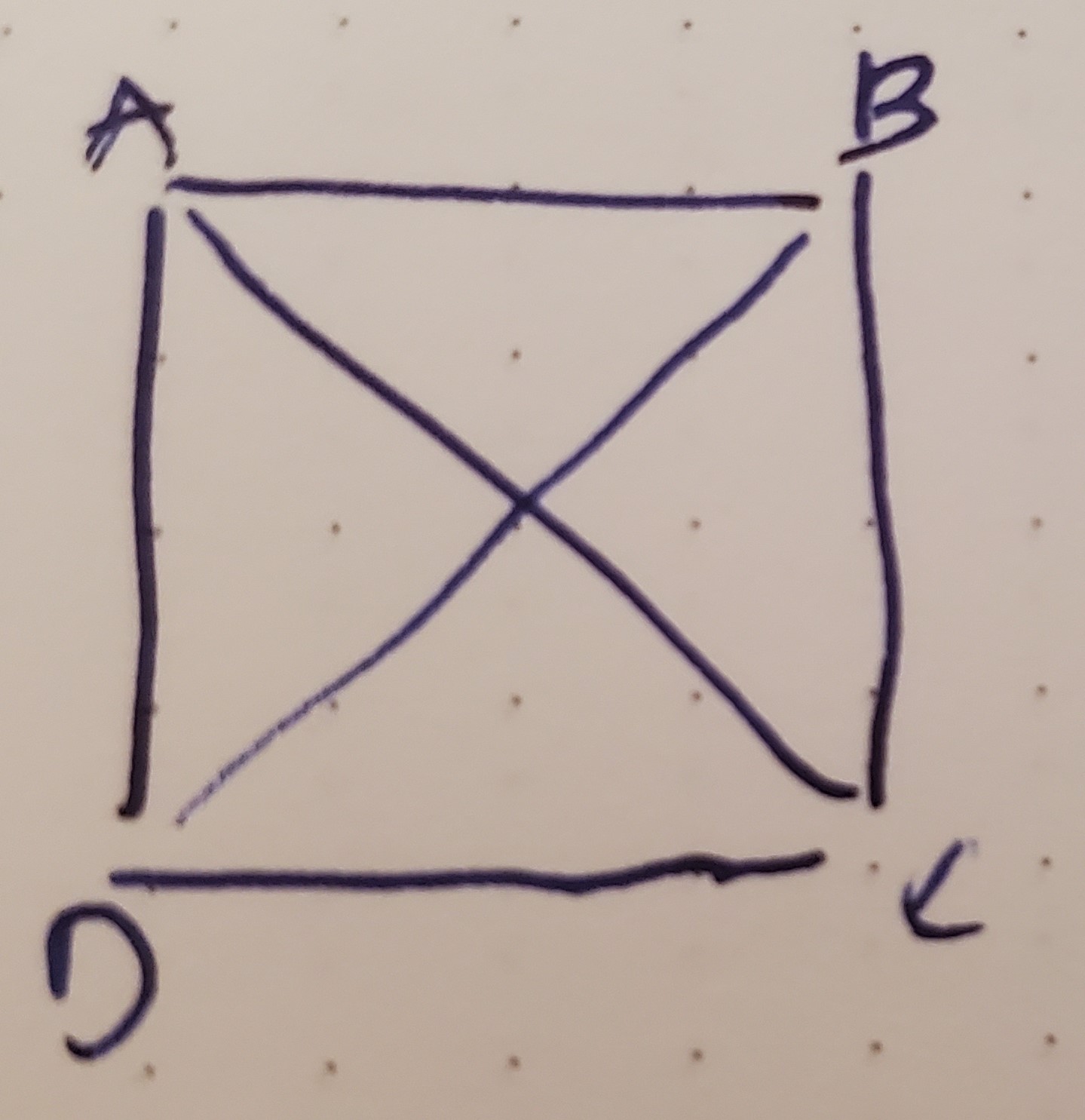The Promised Object::Pad Solution to Weekly Challenge #123
I told you I’d do it, so I did it. I re-solved Challenge #123 Task 2.
To reiterate, we have four points: A, B, C and D.

There are six possible lines: A→B, A→C, A→D, B→C, B→D and C→D. (I assert that A→C is equivalent to C→A.) For a square, the lines A→C and B→D would be
- the longest two lines and
- the same length
So, the steps for a is_square test?
- Check that there are four points. A triangle cannot be a square. A pentagon cannot be a square.
- (For us), make the points Points.
- make lines between every two points.
- sort the lines by length (with the method
distancediscussed previously). - If the four shortest are equally long, then you have a square or a parallelogram. If the two longest are equally long, then you have a square or a rectangle. So you need to check both.
So, that code. I’ll point out that I used the randomizing sort — sort { rand 10 <=> rand 10 } — to ensure that the written order of the data is not the order of points as considered.
#!/usr/bin/env perl
use strict;
use warnings;
use feature qw{ say signatures state };
no warnings qw{ experimental };
use Cwd qw( abs_path );
use File::Basename qw( dirname );
use lib dirname( abs_path($0) );
use CorLine;
use CorPoint;
use JSON;
my $json = JSON->new->canonical;
my @data = (
[ [ 10, 20 ], [ 20, 20 ], [ 20, 10 ], [ 10, 10 ], ],
[ [ 12, 24 ], [ 16, 10 ], [ 20, 12 ], [ 18, 16 ], ],
[ [ 40, 40 ], [ 50, 30 ], [ 40, 20 ], [ 30, 30 ], ],
[ [ 10, 10 ], [ 15, 15 ], [ 20, 15 ], [ 15, 5 ], ],
[ [ 00, 10 ], [ 10, 00 ], [ 00, -10 ], [ -10, 0 ], ],
[ [ 01, 03 ], [ -3, 01 ], [ -1, -3 ], [ 03, -1 ] ],
);
for my $d (@data) {
$d->@* = sort { rand 10 <=> rand 10 } $d->@*;
say $json->encode($d);
say is_square( $d->@* ) ? 'square' : 'not square';
say '';
}
sub is_square ( @base ) {
return 0 unless scalar @base == 4;
my @points;
my @lines;
for my $xy (@base) {
my ( $x, $y ) = $xy->@*;
push @points, CorPoint->new( x => $x, y => $y );
}
for my $i ( 0 .. 2 ) {
for my $j ( $i + 1 .. 3 ) {
push @lines, CorLine->new( i => $points[$i], j => $points[$j] );
}
}
my @shortest = sort { $a->dist <=> $b->dist } @lines;
$#shortest = 3;
my @longest = sort { $b->dist <=> $a->dist } @lines;
$#longest = 1;
return 1
if $shortest[0]->dist == $shortest[1]->dist
and $shortest[1]->dist == $shortest[2]->dist
and $shortest[2]->dist == $shortest[3]->dist
and $shortest[3]->dist == $shortest[0]->dist
and $longest[0]->dist == $longest[1]->dist;
return 0;
}
[[20,20],[20,10],[10,10],[10,20]]
square
[[18,16],[12,24],[16,10],[20,12]]
not square
[[5,3],[3,3],[4,2],[4,4]]
square
[[15,15],[10,10],[20,15],[15,5]]
not square
[[0,10],[10,0],[-10,0],[0,-10]]
square
[[-1,-3],[-3,1],[3,-1],[1,3]]
square